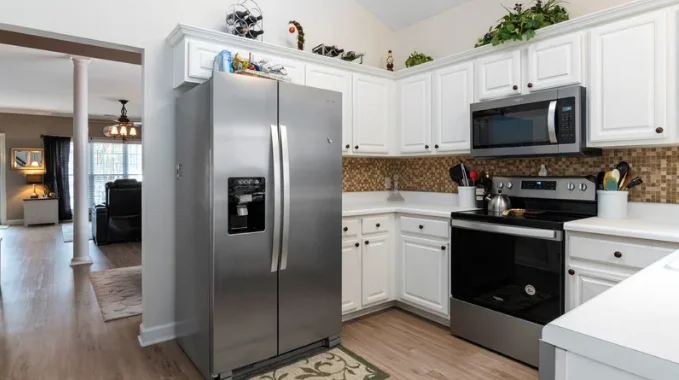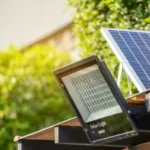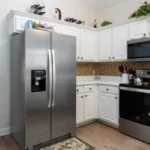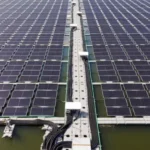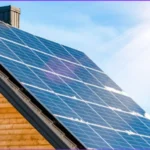Imagine this: It’s the middle of summer, your fridge is stocked with fresh produce, and a power outage sweeps through the neighborhood. Everyone scrambles to keep food from spoiling except you. Your refrigerator is running smoothly, powered entirely by your rooftop solar panels and battery backup. No noise, no fuel, no panic.
That’s the promise of a solar refrigerator, a growing essential for eco-conscious homeowners, off-grid enthusiasts, and small businesses looking to protect perishables while cutting electric bills. But like any technology, the reality comes with both benefits and considerations.
In this guide, we’ll dive deep into how refrigerators work, real-world performance insights, maintenance tips, and how to decide if they’re worth the investment for your lifestyle.
Also click here : solar power outage.
How a Solar Refrigerator Works
A refrigerator is designed to operate primarily from solar power rather than grid electricity. While traditional fridges rely on a constant AC supply, solar refrigerators are optimized to run efficiently on DC power from solar panels, often paired with a battery bank for round-the-clock operation.
Here’s the typical setup:
- Solar Panels – Collect energy from the sun, measured in watts (e.g., a 400W panel).
- Charge Controller – Regulates voltage to protect the battery.
- Battery Bank – Stores energy for nighttime or cloudy days.
- DC Compressor Refrigerator – Uses less power than AC models, reducing strain on your solar system.
- Inverter (Optional) – Converts DC to AC if you’re running a standard fridge.
Pro Tip from the Field:
When I was consulting for an off-grid cabin project in Colorado, we opted for a 12V DC solar refrigerator paired with just two 200Ah lithium batteries. Even in winter, the system kept essentials cold without dipping below 50% battery capacity thanks to the fridge’s high-efficiency compressor.

Why More Homeowners Are Considering Solar Refrigerators
There’s a shift happening. With energy prices climbing and more people concerned about blackout resilience, solar-powered appliances are moving from “off-grid hobby” to mainstream home improvement.
Key Benefits
- Energy Independence – Your fridge keeps running during outages.
- Lower Electric Bills – Reduce the 10–15% of home energy typically used by refrigeration.
- Eco-Friendly – Smaller carbon footprint, especially if paired with other solar appliances.
- Quiet Operation – DC compressors are often quieter than traditional models.
Potential Drawbacks
- Upfront Cost – A quality solar refrigerator and battery bank can run $1,200–$3,000.
- Space Needs – Dedicated panels and batteries take up space.
- Maintenance – Like all solar setups, performance drops with dirty panels or poor battery care.
Also visit here : solar world.
Real-World Performance Factors You Can’t Ignore
Even the best refrigerators rely on the rest of your system being well-maintained.
1. Panel Cleanliness
Dust, pollen, or bird droppings can cut panel efficiency by up to 20%.
One client in Arizona saw their fridge struggling during peak summer not because of faulty equipment, but because their panels hadn’t been cleaned in over six months.
Quick Maintenance Tip:
Check your panels monthly during dusty seasons. A gentle rinse with deionized water works wonders.
2. Battery Health
Lithium batteries typically last 10–15 years, while lead-acid may last 3–7 years. Depth of discharge, ambient temperature, and charging practices all affect lifespan.
- Avoid full discharges. Keep batteries above 20% state of charge.
- Ventilate battery enclosures to avoid heat damage.
3. Inverter and Wiring Losses
If you’re running a standard AC refrigerator on solar, your inverter can waste 5–15% of your power. Switching to a true DC solar eliminates this loss entirely.

Choosing the Right Solar Refrigerator for Your Needs
When shopping, consider the following factors:
1. Capacity
For most households, 5–8 cubic feet is enough for essentials. Larger families may need 10+ cubic feet, but remember, bigger means more power draw.
2. Voltage
- 12V DC – Most common for RVs, cabins, and off-grid homes.
- 24V/48V DC – Better for large off-grid systems to reduce wiring losses.
3. Power Consumption
Look for fridges rated under 60W average draw for maximum efficiency.
4. Climate Rating
If you live in extreme heat, ensure the fridge’s compressor is rated for tropical or sub-tropical use.
Case Study: Small Business Use
I worked with a rural café in New Mexico that switched their dessert fridge to a solar-powered DC model. By dedicating two 350W panels and a 200Ah battery, they kept cold storage running 24/7, even during grid outages that had previously forced them to throw away product. Within two years, the system paid for itself in saved food costs and reduced utility bills.
Installation and System Sizing
Step 1: Calculate Your Daily Energy Needs
If your fridge draws 50W on average and runs 24 hours:
50W × 24h = 1,200 Wh/day (1.2 kWh)
Step 2: Account for Sunlight Hours
In a location with 5 peak sun hours/day:
1.2 kWh ÷ 5h = 240W of panel capacity needed
Add a 25–30% buffer for cloudy days → about 300–350W total.
Step 3: Battery Bank Sizing
For 2 days of autonomy:
1.2 kWh × 2 days = 2.4 kWh battery capacity
That’s about 200Ah at 12V (lithium preferred for efficiency).

Maintenance Checklist for Longevity
- Clean solar panels at least quarterly
- Inspect wiring for corrosion or loose connections
- Test battery voltage monthly
- Defrost fridge if frost exceeds ¼ inch
- Listen for compressor noise changes which can indicate early wear
Troubleshooting Common Issues
Problem: Fridge warms up overnight
- Check battery charge level, you may need more capacity.
- Inspect for phantom loads (other devices draining power).
Problem: Fridge cycles too often
- Clean condenser coils and check door seals.
Problem: Excessive frost buildup
- Reduce door openings, especially in humid weather.
Future Trends in Solar Refrigeration
Manufacturers are experimenting with solar direct-drive (SDD) technology, bypassing batteries entirely for daytime use. This is perfect for vaccine storage or daytime-only needs.
We’re also seeing more hybrid AC/DC models that work with both grid and solar, offering flexibility for homeowners.
Is a Refrigerator Worth It?
If you value energy independence, live in an outage-prone area, or run an off-grid setup, the answer is often yes provided you size the system correctly and commit to basic upkeep.
For full-time grid-tied homeowners, a refrigerator is still an excellent step toward lowering your bills and carbon footprint, especially if you already have a solar array.
Final Thoughts and Next Steps
A solar refrigerator isn’t just a gadget, it’s a piece of your home’s resilience strategy. Whether you’re storing a week’s worth of groceries or keeping café ingredients fresh, the right setup ensures you’re never at the mercy of the grid.
If your panels haven’t been cleaned in over three months, you could be losing 10–20% of your energy output, enough to make your fridge underperform. Book a solar system inspection today and start getting the full benefit of your investment.

